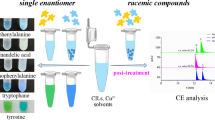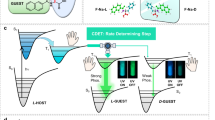Abstract
Optically pure amino acids have extensive applications in pharmaceuticals, pesticides, food, materials, and other fields. Enantiomers recognition of chiral amino acids using optical methods with synthetic chiral sensors has attracted extensive attention. Most reported sensors typically identify guests by covalent or hydrogen bonding or hydrophobic interaction with amino acids and their derivatives. In this paper, a series of ion-type quaternary ammonium salt-based enantioselective fluorescent sensors were synthesized for chiral recognition of free α-amino acids via electrostatic interaction. The fluorescence intensity ratios ID/IL (ID, IL, fluorescence intensity of sensor when treated with D- or L-amino acid) were up to 2.1 and enantioselective fluorescence enhancement ratios ef (ef=[IL−I0]/[ID−I0] or [ID−I0]/[IL−I0]. (I0, fluorescence intensity of the sensor)) were up to 5.0. Among them, sensor 3 showed best enantioselective recognition performance toward tryptophan (Trp), and L-Trp significantly quenched the fluorescence of sensor 3, but D-Trp greatly enhanced the fluorescence of sensor 3, its ID/IL was 2.11 and ef was 1.8. The mechanistic investigation by NMR spectrum revealed that a tight three-point interaction, including electrostatic interaction, hydrogen bond, and π-π stacking, between sensor 3 and D-Trp was formed.




Similar content being viewed by others
Data Availability
The data generated and analyzed will be made available upon reasonable request from the corresponding author.
References
Xue YP, Cao CH, Zheng YG (2018) Enzymatic asymmetric synthesis of chiral amino acids. Chem Soc Rev 47:1516–1561. https://doi.org/10.1039/C7CS00253J
Yu FF, Chen Y, Jiang H, Wang XM (2020) Recent advances of BINOL-based sensors for enantioselective fluorescence recognition. Analyst 145:6769–6812. https://doi.org/10.1039/D0AN01225D
Pu L (2020) Enantioselective fluorescent recognition of free amino acids: challenges and opportunities. Angew Chem Int Ed 59:21814–21828. https://doi.org/10.1002/anie.202003969
Leung D, Kang SO, Anslyn EV (2012) Rapid determination of enantiomeric excess: a focus on optical approaches. Chem Soc Rev 41:448–479. https://doi.org/10.1039/C1CS15135E
Xu KX, Jiao SY, Yao WY, Kong HJ, Zhang JL, Wang CJ (2013) Syntheses and highly enantioselective fluorescent recognition of α-hydroxyl/amino carboxylic acid anions in protic solutions. Sens Actuat B-Chem 177:384–389. https://doi.org/10.1016/j.snb.2012.11.024
Zhu YY, Wu XD, Gu SX, Pu L (2019) Free amino acid recognition: a bisbinaphthyl-based fluorescent probe with high enantioselectivity. J Am Chem Soc 141:175–181. https://doi.org/10.1021/jacs.8b07803
Feuster EK, Glass TE (2003) Detection of amines and unprotected amino acids in aqueous conditions by formation of highly fluorescent iminium ions. J Am Chem Soc 125:16174–16175. https://doi.org/10.1021/ja036434m
Huang Z, Yu SS, Wen KL, Yu XQ, Pu L (2014) Zn(II) promoted dramatic enhancement in the enantioselective fluorescent recognition of functional chiral amines by a chiral aldehyde. Chem Sci 5:3457–3462. https://doi.org/10.1039/C4SC00818A
Iqbal S, Yu SS, Jiang L, Wang XJ, Chen Y, Wang YL, Yu XQ, Pu L (2019) Simultaneous determination of concentration and enantiomeric composition of amino acids in aqueous solution by using a tetrabromobinaphthyl dialdehyde probe. Chem –Eur J 25:9967–9972. https://doi.org/10.1002/chem.201901374
Folmer-Andersen JF, Lynch VM, Anslyn EV (2005) Colorimetric enantiodiscrimination of α-amino acids in protic media. J Am Chem Soc 127:7986–7987. https://doi.org/10.1021/ja052029e
Yang X, Liu XC, Shen K, Zhu CJ, Cheng YX (2011) A chiral perazamacrocyclic fluorescent sensor for cascade recognition of Cu(II) and the unmodified α-amino acids in protic solutions. Org Lett 13:3510–3513. https://doi.org/10.1021/ol2013268
Munusamy S, Muralidharan VP, Iyer SK (2017) Enantioselective recognition of unmodified amino acids by ligand-displacement assays with in situ generated 1:1 cu(II)- BINOL imidazole complex. Sens Actuat B-Chem 250:244–249. https://doi.org/10.1016/j.snb.2017.04.169
Bhattacharyya T, Sundin A, Nilsson UJ (2003) Synthesis of chiral, amphiphilic, and water-soluble macrocycles via urea formation. Tetrahedron 59(40):7921–7928. https://doi.org/10.1016/j.tet.2003.08.019
Chen X, Du DM, Hua WT (2003) Synthesis of novel chiral polyamide macrocycles containing pyridyl side-arms and their molecular recognition properties. Tetrahedron: Asymmetry 14:999–1007. https://doi.org/10.1016/S0957-4166(03)00173-3
Togrul M, Askin M, Hosgoren H (2005) Synthesis of chiral monoaza-15-crown-5 ethers from a chiral amino alcohol and enantiomeric recognition of potassium and sodium salts of amino acids. Tetrahedron: Asymmetry 16(16):2771–2777. https://doi.org/10.1016/j.tetasy.2005.07.002
Demirel N, Bulut Y (2003) Synthesis of chiral diaza 18-crown-6 ethers from chiral amines and molecular recognition of potassium and sodium salts of amino acids. Tetrahedron: Asymmetry 14:2633–2637. https://doi.org/10.1016/S0957-4166(03)00594-9
Pagliari S, Corradini R, Galaverna G, Sforza S, Dossena A, Montalti M, Prodi L, Zaccheroni N, Marchelli R (2004) Chem –Eur J. Enantioselective fluorescence sensing of amino acids by modified cyclodextrins: role of the cavity and sensing mechanism. 10:2749–2758. https://doi.org/10.1002/chem.200305448
Corradini R, Paganuzzi C, Marchelli R, Pagliari S, Sforza S, Dossena A, Galaverna G, Duchateau A (2005) Fast parallel enantiomeric analysis of unmodified amino acids by sensing with fluorescent β-cyclodextrins. J Mater Chem 15:2741–2746. https://doi.org/10.1039/B418369J
Feng HT, Zhang X, Zheng YS (2015) Fluorescence turn-on enantioselective recognition of both chiral acidic compounds and α-amino acids by a chiral tetraphenylethylene macrocycle amine. J Org Chem 80:8096–8101. https://doi.org/10.1021/acs.joc.5b01194
Xiong JB, Xie WZ, Sun JP, Wang JH, Zhu ZH, Feng HT, Guo D, Zhang H, Zheng YS (2016) Enantioselective recognition for many different kinds of chiral guests by one chiral receptor based on tetraphenylethylene cyclohexylbisurea. J Org Chem 81:3720–3726. https://doi.org/10.1021/acs.joc.6b00371
Xiang S, Lv PP, Guo CS, Qi CX, Yang JC, Tian JJ, Yang DS, Feng HT, Tang BZ (2021) Enantioselective recognition of chiral acids by supramolecular interactions with chiral AIEgens. Chem Commun 57:13321–13324. https://doi.org/10.1039/D1CC05618B
Li JQ, Geng S, Liu BG, Wang HB, Liang GZ (2018) Self-assembled mechanism of hydrophobic amino acids and β-cyclodextrin based on experimental and computational methods. Food Res Int 112:136–142. https://doi.org/10.1016/j.foodres.2018.06.017
Ugawa T, Nishikawa S (2001) Kinetic study for molecular recognition of amino acid by cyclodextrin in aqueous solution. J Phys Chem A 105(17):4248–4251. https://doi.org/10.1021/jp003968q
Bae HY, Some S, Lee JH, Kim JY, Song MJ, Lee S, Zhang YJ, Song CE (2011) Organocatalytic enantioselective michael-addition of malonic acid half-thioesters to β-nitroolefins: from mimicry of polyketide synthases to scalable synthesis of γ-amino acids. Adv Synth Catal 353:3196–3202. https://doi.org/10.1002/adsc.201100458
Wang YK, Wang SF, Wu YF, Zhao T, Liu J, Zheng JL, Wang L, Lv JL, Zhang T (2023) Fast, highly enantioselective, and sustainable fluorination of 4-substituted pyrazolones catalyzed by amide-based phase-transfer catalysts. Org Chem Front 10:2226–2233. https://doi.org/10.1039/D3QO00269A
Ilisz I, Bajtai A, Lindner W, Péter A (2018) Liquid chromatographic enantiomer separations applying chiral ion-exchangers based on Cinchona alkaloids. J Pharmaceut Biomed 159:127–152. https://doi.org/10.1016/j.jpba.2018.06.045
Majdecki M, Niedbala P, Jurczak J (2019) Amide-based cinchona alkaloids as phase-transfer catalysts: synthesis and potential application. Org Lett 21:8085–8090. https://doi.org/10.1021/acs.orglett.9b03065
Akdeniz A, Mosca L, Minami T, Anzenbacher P (2015) Sensing of enantiomeric excess in chiral carboxylic acids. Chem Commun 51:5770–5773. https://doi.org/10.1039/C5CC00376H
Acknowledgements
The authors acknowledge financial support by the National Natural Science Foundation of China (NSFC), the Natural Science Foundation of Gansu Province, the Science and Technology Plan Foundation of Lanzhou, the Young Teacher Research Foundation of Northwest Normal University.
Funding
This work was supported by the National Natural Science Foundation of China (NSFC, Grant Nos. 22367021 and 22061025), the Natural Science Foundation of Gansu Province (Grant Nos. 21JR7RA124), the Science and Technology Plan Foundation of Lanzhou (Grant Nos. 2023-3-113), the Young Teacher Research Foundation of Northwest Normal University (Grant No. NWNU-LKQN2019-15).
Author information
Authors and Affiliations
Contributions
L.B. designed the experiments and wrote the manuscript, C.L. and D.W. completed all experimental work, C.X. provided supervision and completed review.
Corresponding author
Ethics declarations
Ethical Approval
This article does not contain any studies involving human participants conducted by any of the authors.
Competing Interests
The authors have no competing interests to declare that are relevant to the content of this article.
Additional information
Publisher’s Note
Springer Nature remains neutral with regard to jurisdictional claims in published maps and institutional affiliations.
Electronic Supplementary Material
Below is the link to the electronic supplementary material.
Rights and permissions
Springer Nature or its licensor (e.g. a society or other partner) holds exclusive rights to this article under a publishing agreement with the author(s) or other rightsholder(s); author self-archiving of the accepted manuscript version of this article is solely governed by the terms of such publishing agreement and applicable law.
About this article
Cite this article
Bai, L., Li, C., Wei, D. et al. Enantioselective Fluorescence Recognition of Free α-Amino Acids by Ion-Type Ammonium Salt-Based Sensors. J Fluoresc (2023). https://doi.org/10.1007/s10895-023-03568-7
Received:
Accepted:
Published:
DOI: https://doi.org/10.1007/s10895-023-03568-7




